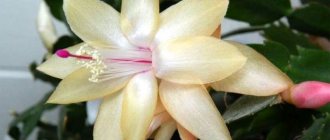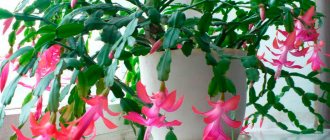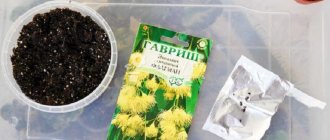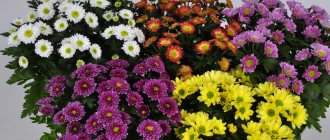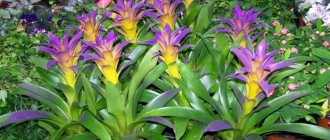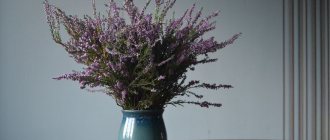Many gardeners, especially lovers of exotic flowers, are interested in adding hemanthus to their indoor flower collection - an ornamental South African plant with amazing bright flowers that look like light fluffy balls. To enjoy the unique beauty of exotic flowers, you will have to wait at least 4, or even 5-6 years, and during this entire period provide the plant with proper care.
This article describes how to care for hemanthus at home, what difficulties you may encounter, and how to overcome them.
Botanical description
The homeland of this simple but lovely flower is the tropical jungle of the African continent. It was brought to Europe by its discoverers during the Age of Enlightenment in the 18th century. Lovers of wonders liked it thanks to its simple care.
Hemanthus unites a large genus of the Amaryllis family and belongs to the monocotyledonous flowering plants. Its name means blood-red flower in Latin, referring to the bright and large inflorescence - the French discoverer Joseph de Tournefort was the first to find the red hemanthus, recklessly naming the entire genus - although it also contains white-flowered species.
The inflorescences are umbellate, with long fluffy stamens, surrounded by beautiful fleshy bracts. The flower is self-pollinating, and due to this botanical feature it does not have the most pleasant smell.
The appearance of the fleshy leaves indeed resembles a rough tongue, slightly curved at the tip and with an elongated, elongated dimple in the middle.
Fans of indoor floriculture have given it many other, more appropriate names - elephant's ear or deer's tongue, referring to the curved and wide dark green leaves.
Hemanthus is a bulbous plant that produces leaves in pairs. From each bulb grow from one to three pairs of symmetrically hanging leaf blades. He grows them slowly, a couple per season. The texture, depending on the type of flower, can be pubescent, glossy and even sticky to the touch.
Hemanthus does not have a pronounced rest period, continuing to grow even in the winter months. In spring, it takes in the sun and produces pubescent inflorescences in scarlet, burgundy, white, orange or cream shades.
After flowering, the fruit ripens - a fleshy, inedible, white-red, round berry. Its size is about one and a half centimeters. The seed material from it remains viable for a very short time; it cannot be prepared for the future.
The juice of this plant is slightly toxic and can cause local irritation or chemical burns. Therefore, it should be kept away from small children and pets, especially during the period after flowering, when the seeds ripen in the cute-looking - but inedible fruits.
Possible problems during care
- If yellow and brown spots appear on the plates, it means that the flower has received sunburn and needs to be moved to a more shaded place.
- The pale color of the foliage indicates a lack of sunlight, and in this case it is necessary to take care of brighter lighting.
- Dried edges of leaf blades indicate a lack of moisture, and if they droop down, turn yellow and wrinkle, then, on the contrary, there is too much water. In such a situation, it is important to establish the correct watering regime by first transplanting the flower onto a good drainage layer. It should be borne in mind that yellowing of the lower leaves of the plant may simply be associated with the onset of a dormant period.
- If development slows down, it means that parasitic insects have appeared on the crop, taking away vital juices. The bush must be carefully examined and appropriate measures taken to combat parasites. The cause of the problem may also be soil deprived of nutritional value, and then it is necessary to replace the substrate.
- Blackening of the buds may be due to:
- with increased soil moisture due to violation of the irrigation regime;
- using cold water - it should be room temperature;
- low air temperature - optimal values during the active period are +18...+23 °C.
- The appearance of a whitish coating on the foliage is evidence that the water is excessively hard. To soften, add a few drops of vinegar or a pinch of citric acid.
White-flowered
A magnificent representative, endowed with flat and wide, slightly curled leaves.
Their color is light green, glossy and juicy. The surface is slightly pubescent, the length can reach twenty and the width eight or nine centimeters. The flowers are white, large, studded with snow-white stamens with rich yellow tips. The peduncles are short, up to twenty centimeters. The inflorescence resembles either a ball or a pompom. It begins to bloom in spring, flowering lasts from two to three months. It is the most popular type among the rest. The bulb rarely exceeds seven to eight centimeters.
You can see what the Hemanthus Belotsvetkovy variety looks like in the photo below:
Hemanthus white-flowered
Katarina
Refined and sophisticated, it has elongated and, relative to other types, thinner leaves, slightly carved at the edges. They are placed on a false stem up to fifteen centimeters long. Their color can range from dark green to light grassy. May have an ovoid shape.
The inflorescence is very large, lush, sometimes studded with the finest fluffy stamens, pink-coral or scarlet flowers. A hefty and wide peduncle can grow about thirty centimeters, the perianths are reduced. Thanks to its unusual color and shades of scarlet , it is popularly called the blood lily, although it has nothing to do with the lilies. The bulb is large, up to ten centimeters.
In the photo below is the Hemanthus Katarina variety:
Hemanthus Katarina
Sharlakovy
Its distinctive pair is the most impressive size among its relatives; the bulb can exceed ten centimeters. Their leaves are decorated with reddish tips, their height can reach half a meter.
The thick and stocky peduncle is decorated with small brownish specks, the perianth is lush, bright red, very noticeable. For its enormous size, the flower had to pay with the frequency of flowering and its duration. Its stamens can take on yellowish or coral shades.
The photo below shows Hemanthus Sharlakovy:
Hemanthus Sharlakovy
brindle
Tiger is distinguished by short peduncles and long leaves, dotted near the very base with spots of brownish shades. The inflorescence is large and very beautiful, surrounded by five or six large and sleepy perianths of red shades. The flowers themselves in inflorescences are red-pink in color, the stamens are dark yellow.
A neat, delicate flower on a squat peduncle looks great.
Hemanthus Tiger
Types for indoor growing
Not all types of hemanthus are suitable for breeding at home, but only a few of them, namely:
- Haemanthus Lindenii (Hemanthus Linden) with wide, fleshy, rounded leaves and red flowers;
- Haemanthus puniceus (pomegranate) with purple or scarlet inflorescences and narrow light green leaves;
- Haemanthus tigrinus (tiger) with spotted foliage and large purple-red flowers;
- Haemanthus Katharinae - one of the most beautiful, with large leaves, blooming with bright red flowers;
- Haemanthus albiflos (white-flowered) - blooms from August to January, producing white inflorescences with yellow stamens at the ends, has wide, dense foliage of a dark green hue;
- Haemanthus multiflorus (multifloral), distinguished by its long peduncles and thick umbels of orange or bright red hue, with up to 6 pairs of leaves;
- Haemanthus coccineus (scarlet) with one or two pairs of leaves, sometimes spotted, and large bright red flowers.
Read more about hemanthus varieties for growing in pots here.
Garnet
Hemanthus Garnet is very cute and has a beautiful appearance. Its peculiarity is its gorgeous, incredibly lush red-yellow flowers with an orange tint. Sometimes their color can have garnet shades. The bulb is large, about eight to nine centimeters in diameter. The leaves are dark green and long, with an elongated wavy shape from fifteen to thirty centimeters.
Flowers - long pistils collected in a huge and lush bunch, among orange-scarlet petals, shorter but fluffy. The perianths range from dark purple to dark green. Blooms from mid-summer to late autumn.
Hemanthus Garnet
3. Hemanthus species:
3.1. White-flowered haemanthus - Haemanthus albiflos
An evergreen perennial plant up to 30 cm high with oblong-oval, thick, light green leaves arranged in opposite pairs. Sometimes the leaves have short, delicate pubescence. Peduncles are tall, erect, leafless. Peduncles are short, strong, leafless. The inflorescence is a large fluffy umbrella, reaching a diameter of 8 cm and resembling a pompom.
↑ Up,
Multifloral
Multiflowered is a rather large specimen: the bulb is about eight centimeters. Its rich green leaves have noticeable longitudinal patterned veins. The leaf blades are short and leathery to the touch and have a short petiole.
The peduncle is colored in a dark emerald or dark brown shade and can reach eighty centimeters in length. The umbellate inflorescence consists of noticeable individual flowers, of which there can be up to hundreds.
Hemanthus Multiflora
Types of elephant ear
The genus includes 22 species; under natural conditions, they are all distributed only in South Africa. Most species are deciduous, only three of them are evergreen succulents. Most often in nature you can find red hemanthus, but its white variety is more popular as an indoor flower.
Reference! Previously, the genus consisted of almost twice as many varieties, but in the last century some were separated into a separate family of Amaryllidaceae.
Only some species are bred for indoor flower beds.
Recommended by topic
Cyclamen (Alpine violet) Juniper Basic rules for watering indoor plants Zephyranthes Although this flower is considered an unpretentious representative of the rich African flora, you cannot completely throw it in the room like cacti or succulents - it will shed its leaves. Growing them is a costly process for the bulb. You should follow a number of fairly simple rules so that it grows calmly in your home and blooms during the spring season of warm and soft sunlight.
Lighting
The flower does not tolerate direct rays of the sun, but it also does not grow well in constant darkness. The best option for its constant and comfortable growth is soft and bright, but diffused light. Midday bright rays can burn the foliage - it is unable to recover and gradually fades.
Gemanthus feels best on western or eastern windows. Many people like ventilation in warm and mild weather. A balcony or loggia in summer without direct sunlight is the best choice.
Temperature
Depending on the time of year, this flower is suitable for different temperatures. In summer, it feels good in the temperature range from +18 to +23 degrees. Higher rates may dry out the flower. In winter, comfortable conditions imply a decrease in temperature from +10 to +14 degrees.
Only the white-flowered hemanthus is able to completely do without seasonal cold - it grows quite successfully at any time of the year, but can stretch out in the shade. Therefore, in winter it makes sense to organize additional lighting for it with a phytolamp or a regular table lamp.
Expert opinion
Victoria Goncharova
Specialized education: landscape designer, agronomist, gardener. Experience in caring for potted fresh flowers/plants at a professional level!
The remaining species fall asleep for the winter in order to accumulate more strength in the bulb.
Humidity and watering
This unpretentious exotic flower is quite capable of withstanding a short break in watering, but due to excessive watering it can begin to hurt and wither. Water after the substrate has dried by about half, taking into account the bulbous nature of the hemanthus.
In winter, watering is reduced to prevent rot from occurring in the cool air. The flower spends less water in the gloomy days of our winter - therefore, excessive watering can harm it.
Top dressing
From spring to early autumn, hemanthus can be fed once every fourteen to twenty days to stimulate flowering and the growth of new leaves. Without feeding, its growth will slow down significantly, and flowering may not occur, since it is a rather energy-consuming enterprise for the bulb.
In winter, hemanthus is not fertilized to avoid the appearance of elongated leaves, excessive waste of energy and excessive moisture. It must be remembered that bulbous plants are very sensitive to waterlogging; their outer scales should not rot or decompose.
Transfer
It is important to remember that the hemanthus bulb contains caustic substances that irritate the skin. Therefore, to avoid itching and red spots, you need to wear gloves before transplanting.
The bulb is undemanding to care, and its delicate roots are not adapted to stress. That is why hemanthus is replanted quite rarely, once every four or five years. Usually, instead of replanting, they replace the top layer of substrate and replace it with a new one.
In case of urgent need, the hemanthus is replanted at the beginning of March or the end of February, then the bulb is still dormant and can withstand replanting into new soil without problems.
If the old container has simply become small, it is better to transfer it to a new pot without dismantling the old lump, this will save the hemanthus, and in the new season it can please you with more vigorous flowering.
Priming
This flower is undemanding to the composition of the soil, the main thing is cleanliness and the absence of an excessive amount of organic matter. You can prepare the soil yourself from:
Two parts of turf land
One part of garden soil
Humus parts
Another option is to replace the humus with:
One part peat
One part sand
Store-bought soil is perfect for amaryllis - a loose and breathable, but sufficiently nutrient-rich substrate from a store-bought soil mixture will ensure at least a season of healthy development.
Pot
Since the plant does not form many roots, an appropriate container is selected for it - shallow, only three or four centimeters larger than the bulb itself.
Be sure to lay a drainage layer of expanded clay and small pebbles at the bottom, since the crop does not tolerate dampness and can get sick from it.
Trimming
When the bulb is about to go into hibernation, the lowest leaves may begin to turn yellow and dry out - this is an absolutely normal phenomenon, and there is no need to be alarmed. You should carefully cut the leaf blade to the level of the neck of the bulb or retreating about half a centimeter - so as not to disturb it again. This way you will prevent the possible development of pathogenic microflora or fungi in the dying leaf.
Sanitary or decorative pruning during active growth may be used in cases of severe sunburn or excessive drying of the leaf. It is better to comply with the conditions and not make such mistakes than to reanimate the hemanthus later.
Old leaves can be used on leaf cuttings at the beginning of spring - this will not only allow the hemanthus to propagate, but will also rejuvenate it, forcing it to grow a new leaf. But remember: in one season, the bulb cannot produce more than two new leaves.
Reasons why they don't bloom
The reasons why flowering does not begin for a long time include:
- Violation of rest mode. To provide the plant with optimal conditions during this period, it needs to be moved to a cooler, well-lit place, and watering should be reduced as much as possible.
- The landing capacity is too large. A flower cannot fully develop if the volume of the pot does not correspond to the size of its root system, so it is necessary to transplant it into a smaller container, the diameter of which does not exceed the width of the upper part of the plant, and for some time add a biostimulant to the water when watering.
- Heavy soil in which moisture stagnates. Such soil should be replaced with a light substrate containing peat, bark and charcoal.
- Insufficient watering during the growing season. It is necessary to establish the correct watering regime, compliance with which is very important for the normal development of hemanthus.
- Low air temperature, the presence of drafts and insufficient fertilizing can also cause a lack of flowers, so it is important to follow the recommendations for caring for the crop, avoiding violations.
Reproduction
Since the plant is bulbous, it is slow to propagate it generatively, but this way you can obtain new varietal qualities. Most often, budding basal children are used, which are formed at the very roots - or vegetative propagation of cut leaf cuttings.
Leaf cuttings
To prepare a leaf cutting, you need to wait for a period of active growth, otherwise the separated leaf will most likely wither and not grow its own roots.
To increase the chances of rooting, root is used, applied to a fresh cut of a leaf.
Many gardeners, in order to avoid leaf rotting in damp soil, pre-treat it with phytosporin or other fungicidal preparations.
It is not recommended to cover the seedling during rooting, as this creates excessive moisture. Do not expose the rooting leaf to light - otherwise it will waste precious water on photosynthesis. Instead, it is better to choose a slightly shaded and moderately warm corner.
Children
Perhaps this is the easiest way - during the next inspection and replanting, you can carefully separate from the root system the already formed basal bulbs that have budded from the main plant - and immediately root them in a separate container.
They will need time to adapt and grow their own roots; at this time, pay special attention to watering and do not allow liquid to overflow. After a little over a week, you can start feeding the young plant and the old bulb - by this time the scars on the roots will have completely healed.
The baby does not need to be surrounded by special conditions - it is a fully formed plant, capable of developing independently in an adult, well-drained container. Make sure it has enough light, feed it as needed and maintain moderate watering so that the new hemanthus can bloom as quickly as possible.
Seeds
This is a rather painstaking procedure that requires skill and patience, because a full-fledged hemanthus will grow from a seed only after five to seven years.
To obtain seeds, the hemanthus flower is carefully and carefully pollinated with a soft natural brush, transferring pollen between two flowers.
It is better to plant the seeds obtained when extracting them from berries immediately; storage, if necessary, is organized at +5 degrees. Each seed is planted immediately in a ready-made adult pot, carefully sprinkled on top with a thin layer of soil (no more than two to three millimeters) and watered moderately, monitoring the condition.
The temperature during pecking should be about +20 degrees, lighting should be provided for sixteen hours.
As soon as the sprout appears, watering is increased slightly. Young bulbs need additional lighting for one and a half years.
It is necessary to add nitrogen, phosphorus and potassium in a ratio of four parts to one to three - then the bulb can grow into an adult state in two years.
How to properly transplant deer tongue
It is recommended to replant the flower annually in early spring. If there is a lot of free space in the pot for the development of the root system, then you can leave the plant in this container for some more time.
Know! You cannot replant the plant less than once every three years.
For hemanthus, you should take wide and shallow pots. Drainage is placed at the bottom to prevent stagnation of water. It is necessary to select light, breathable soil. Mix greenhouse, deciduous and tree soil in equal parts, add a little peat and bone meal. It is advisable to add a little humus.
If this is not possible, then you can purchase ready-made soil for bulbous plants at specialized points. When transplanting, the planting material requires careful handling, otherwise the roots can be damaged and go deeper into the ground a little more than half. There should be no more than 4 cm of free space from the edge of the pot to the bulb.
This video explains how to propagate hemanthus and also plant it.
Can I buy blooming hemanthus in the store?
Many supermarkets and large retail chains bring incredibly beautiful bulbs once a season, already blooming vigorously with huge inflorescences.
Amaryllis and hemanthus are no exception. It is worth remembering that they are usually imported to such places from Holland, which has built a centuries-old business in the flower trade. Unfortunately, the flow trade of such flowers often affects the quality of the plant: in order to speed up flowering, exorbitant doses of fertilizers and constant, almost round-the-clock illumination are pumped into it . In addition, large greenhouses often do not monitor the absence of pests - so the purchased magnificent hemanthus may contain unpleasant surprises in the form of scale insects, nematodes or root rot. Such flowers can live for a maximum of six months or a year, after which they will wither.
If you are drawn to buy a flower at this particular time, remember that you need to be the most pragmatic and prudent gardener: choose a specimen with the largest and strongest bulb, unopened buds and dry soil - retail chains rarely care about observing individual conditions and often water everything to a state of abyss.
Examine carefully to see if there is a whitish coating of fungi on the scales, suspicious spots on the leaves or spider mites. Feel free to turn pot after pot - you are the buyer and have the right to choose the best product from those offered.
After purchasing, get ready to cut magnificent flowers - the hemanthus will need to be trained from watering oversaturated with fertilizers to normal soil and moderate fertilizing. With this care, the bulb will not burn out in one year, as usually happens, but will begin to bloom moderately on your windowsill year after year.
Diseases in pests
The plant is affected by fungal diseases and attacked by insects:
- Staganosporosis threatens Amaryllis specifically - red-orange spots and stripes appear on leaves, peduncles, buds, and bulbs; it is called red rot. It is necessary to remove the infected areas, replant the plant, and cut off the affected parts of the bulbs. Treat with drugs to combat fungal infections (Oxic, Fundazol), copper sulfate.
- Spider mite - forms a thin web, colorless dots appear. Spray with Aktellik, Aktara.
- Scale insects - first remove it with a cotton swab soaked in soapy water, then shower the flower and spray it with karbofos.
- Gray rot - necrotic spots form, discard the plant; this disease cannot be treated.
- Aphids and thrips can also appear on hemanthus. Treat with special chemicals.
In order to prevent diseases, the substrate for the flower should be disinfected and checked regularly for the presence of pests. Overwatering can cause more damage than drought.
Diseases and pests
The main enemy of this indoor dweller is waterlogging. It causes dry bulb scales and roots to rot, leaves to rot and root nematodes, fungi and amaryllis mealybugs to appear.
The danger is gray root rot - it affects all tissues of the flower; it can only be saved by radical pruning of the roots and replanting in sterile soil.
Leaves can be affected by:
Shchitovka
Red spider mite
Bathing the foliage in soap will help prevent them - make sure the bulb remains dry. But systemic insecticides and quarantine for the affected plant will be more effective.
If the hemanthus is damaged by a mealybug, it is necessary to urgently shake it out of the pot, treat it with an insecticide and replant it in new sterile soil - otherwise the pests will simply eat the bulb from the inside. Any pests need to be monitored and stopped at the very beginning.
Why doesn’t it bloom and what to do?
Low room temperature, watering with cold water or excessive moisture can cause the buds to darken and fall off. Slow development and the absence of flowers indicate impoverishment of the soil; it’s time to apply fertilizer. You need to water the fertilizer carefully, without getting it on the bulb or leaves - otherwise there is a chance that it will get inside the scales and cause rot there.
Pale foliage and the absence of inflorescences most often mean a lack of light, and brownish and yellowish spots are burns from the bright sun. Make sure that the coma is not over-moistened - a swamp in the roots can also prevent the hemanthus from blooming.
If the flower arrow of the hemanthus cannot crawl out of the axil of the leaves, it lacks fertilizer and light. Provide it with high-quality fertilizing with a mixture for amaryllis and observe the supplementary lighting regime, then the flower can grow a healthy flower arrow.
Flowering and dormant period
The crop blooms for the first time at the age of 4, when the diameter of the bulb reaches 5 cm: a thick fleshy peduncle with a spherical bract at the top grows from the false stem.
The main flowering period of different types of hemanthus occurs in the summer (July-August) and lasts until the end of September, that is, 2-3 months.
The beautiful flowers emit a rather unpleasant smell, and when they bloom, fruits appear in the form of berries with seeds that ripen by December.
The dormant period - rest from growth and flowering - begins around mid-October and lasts until the end of February. At that time:
- stop fertilizing and minimize watering;
- provide the flower with a lower ambient temperature (+10…+14 °C);
- If the foliage turns yellow, move the pot to partial shade.
Resuscitation of hemanthus without roots
Loss of the root system of the bulb can occur due to errors in care - excessive watering, exceptional dryness during the dormant period, pests in the soil due to moisture, too cold wintering.
To revive the bulb, you need to do the following:
Dig up and clear the soil, remove the remains of old rotted or dried roots.
If necessary, wipe the bulb from possible microbes with a pink solution of potassium permanganate and a gauze swab.
After treating with root, plant the bulb in a fresh and slightly moist substrate - some use a mixture of regular soil and sand to avoid stagnation of water.
Maintain the temperature around +22...+24 and indirect soft lighting to awaken the sleeping bottom and fresh roots;
If there are leaves on the hemanthus, we monitor their filling with juice; a drop in turgor and tone of their tips will be a sure signal for watering.
After such resuscitation, the bulb will wake up and begin to grow new roots and leaves.
We maintain moderate watering and begin to carefully fertilize a week after the emergency transplant.
Hibernation does not mean a complete cessation of bulb growth - it can be reduced, but not stopped. Many gardeners soak the bottom in stimulants for several hours before planting - but this can cause infection of hemanthus tissues by pathogenic microorganisms.
Transfer
Bushes that have not reached 5 years of age are replanted annually, each time increasing the volume of the pot. Starting from 5 years, when the plant is already considered an adult, it is enough to replant once every 3-4 years.
This is done in late February-early March as follows:
- Prepare a new container, the volume of which corresponds to the increased size of the flower’s root system, place drainage on the bottom and partially fill it with substrate.
- Gently loosen the soil along the edges of the old container using a thin wooden stick to remove the plant along with the earthen lump.
- Place the flower in a new pot, adding soil mixture so that the bulb is buried a third.
- The soil is slightly compacted and watered with water with the addition of the growth stimulator "Epin" using a spray bottle.
- In order for the culture to take root well, a biostimulant is also added to the water during several subsequent waterings.
Signs and superstitions
Popular rumor endowed hemanthus with truly terrifying properties: from energy vampirism to incredible toxicity, poisoning not only the room, but also the inhabitants and guests. In fact, such fears are groundless and are usually based on the Latin name blood lily - but as already said, they gave it for reasons of pretentiousness and for greater popularity of the discoverer.
Other idle rumors of toxicity are based on the burning juice of the hemanthus and the not very pleasant amber during flowering, but the flower is not so poisonous. The only thing that is toxic is its bulb - but few people would think of digging it out of the soil and eating it unpeeled, and when replanting it is enough to use gardening gloves.
The traditional Chinese teaching of Feng Shui, on the contrary, considers hemanthus to be a magnet for financial energy flows, and its peculiar approach to flowering, on the contrary, cleanses the invisible substance of qi around itself - and in the end, for good reason: by ventilating the room from not the best aromas, you let in more freshness and creativity, since it is much easier to think and create in the fresh air. By the way, despite the unpleasant reaction of some people, the smell of hemanthus stabilizes blood pressure and gently stabilizes metabolism.
There is also a belief that with his presence he rids the home of brought negativity and bad thoughts, protecting the owners from outside malice.
Interesting facts about hemanthus
Hemanthus will help its owner improve overall well-being, as it helps enrich the room with oxygen and ozone, as well as aerons, which will lead to the creation of healthy “electrostatics” in the room. “Bloody Flower” leads to the improvement and stabilization of metabolic processes in the human body and the acceleration of recovery processes. In this case, the pressure of everyone nearby in the hemanthus is normalized. If you place a flower pot next to electronic equipment (computers, TV and other devices), then
There is a decrease in their impact on humans. This all happens due to the fact that hemanthus can enhance sound absorption and generally create an aesthetically pleasing and comfortable environment in the premises.
It is customary to decorate not only living rooms with this unusual flower; it also looks great in office spaces, as it is unpretentious and blooms profusely. Interestingly, flowers can be dried perfectly and then used to create dried flower arrangements. Hemanthus works well next to ficus or ivy.
